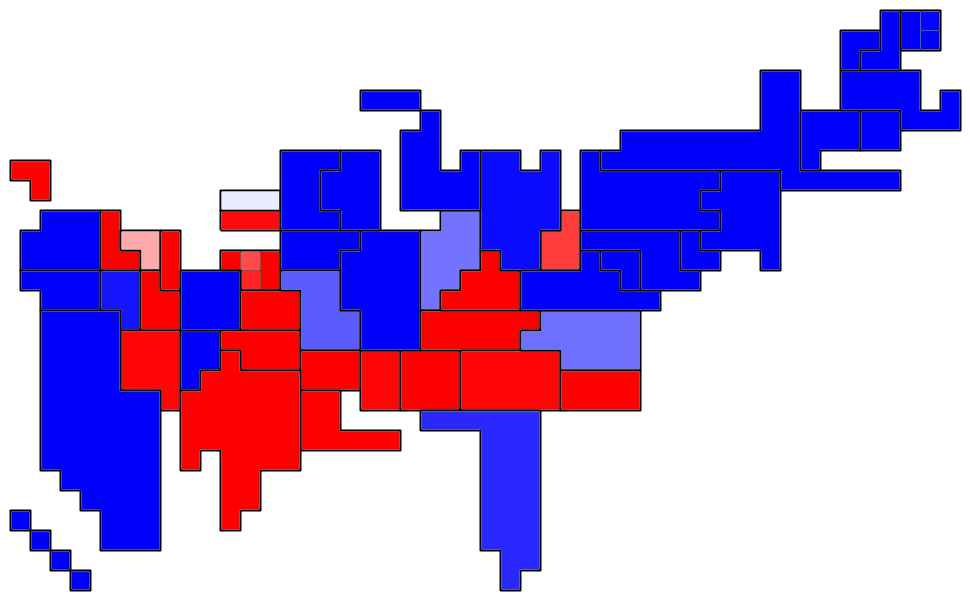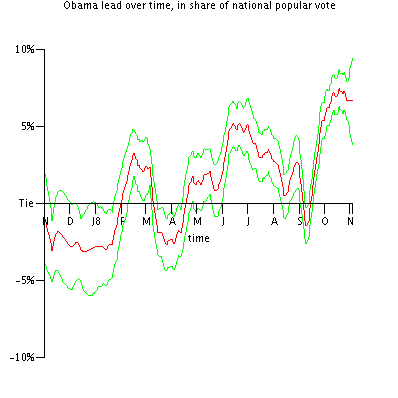Popular Vote, Very Funny
I just made a popular vote prediction based on my data. Results: Kerry 49.54% and Bush 50.46% among Kerry and Bush voters, despite Kerry's strong lead in the Electoral College.
I remember from before the 2000 election that the Bush camp had a plan to delegitimize Gore if Gore had won the electoral vote but lost the popular vote, as most commentators thought was likelier than vice versa. That same idea this time around would might be too much chutzpah even for the Bushies.



1 Comments:
A LiveJournal user asks if I have any links (besides my memory of it being discussed on the radio in October 2000) to back up the statement, "the Bush camp had a plan to delegitimize Gore if Gore had won the electoral vote but lost the popular vote, as most commentators thought was likelier than vice versa." I do.
Pre-election sources are actually hard to find nowadays, and the electoral college wasn't on many people's minds before the 2000 election. I finally got some links by Googling the entire phrase "if bush wins the popular vote". On Republican plans to delegitimize Gore: New York Daily News, 11/1/2000 and Bush Watch, 11/6/2000. On the common belief in Gore's advantage in the electoral college: something from 10/28/2000, something from 11/7/2000. On actual evidence for Gore's advantage in the electoral college: a study from 11/4/2000.
Since people gave such credence to studies like the one linked above before the 2000 election, I'll spend a little while debunking it.
This study found virtual certainty that Gore would win the electoral college in the event of a dead heat in the popular vote. There are, however, at least two problems with their study. First, by pooling all available poll data for each state, they express far too high a confidence that Gore would win Florida, New Hampshire, Tennessee, and even Missouri. (In the other direction, they got Oregon wrong.) This confidence in amalgamated polling data from a large time frame was unjustified: If, say, national polls were static, but New Hampshire polls swung from Gore to Bush near election day, then their analysis would predict a certain Gore victory in New Hampshire (on the weight of older polls) but common sense tells us that Bush could very well win. My methodology on this site seeks to avoid this problem by giving polling data weights that decrease exponentially over time.
Second problem: To make calculations on what would happen in the event of popular-vote tie, they took state-by-state polling data and national polling data, and then adjusted the states' numbers to make the national vote into a tie. The underlying assumption, which they put far too much confidence in, was that a shift (to a tie) in national opinion would be accompanied by a similar shift in each state's numbers.
In fact, a shift in national opinion might entail other kinds of changes in states' numbers (see Table 1): For example, a national gain for Gore resulting from Nader voters returning to the fold would have a greater effect in liberal states than in swing states; extra Gore votes in these liberal states (especially California, which got about 100,000 more Gore votes than these guys predicted) would be wasted votes. Or, a gain for Gore resulting in unpredictable undecideds favoring Gore (as turned out to be the case) might have a greater effect in non-swing states, which had been inundated less by ads; these votes too would be wasted votes. In either case, these wasted Gore votes brought the election closer to a Gore popular victory, while still leaving the electoral college odds somewhere in the middle of this study's Graph 3.
Third problem: Numerically, these authors did an excellent job of predicting most states' percentages given a national tie. The one exception was Texas, where, despite little (and probably old) polling data, they predicted Gore to get only 29.2%, with a 95%-confidence margin-of-error of only 4.2% (either mentally or with paper, take the square root of the variance 0.000445 and multiply by 2). In fact, Gore got over 39% of the two-party vote in Texas. This is a swing of over 600,000 votes. With all these wasted Gore votes (and another 100,000 or so in California), Gore was easily able to lose (relative to this study's predictions) 50,000 in Florida, 40,000 in Missouri, 10,000 in New Hampshire, and 30,000 in Tennessee necessary to blow the election and still win the popular vote.
Ultimately, I think there may be, in today's political climate, a slight advantage for Democrats in the electoral college, since Republicans win with such huge margins out West. Nevertheless, there are such varying influences on each state (and particularly on each swing state) that one must be circumspect about making statistical claims of the form "if the national race shifts to a tie position, then swing state X will go to Kerry with extremely high probability." Certainly, the confidence statements taken from head-to-head polls (particularly old ones) do not translate directly into confidence statements on such hypotheticals, as so spectacularly demonstrated by the failure of this paper.
Post a Comment
<< Home